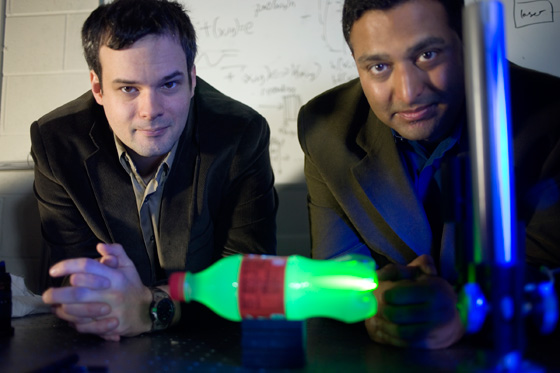MIT researchers have created a new camera imaging system that can capture visual data at the rate of one trillion exposures per second. That means you can take a video of a light beam, slow it down and you can actually see light particles moving. How cool is that?
Ramesh Raskar, Moungi Bawendi (both professors at MIT) and Andreas Velten (Postdoc associate with Ramesh) are the brains behind the world's fastest camera. Andreas likes to call it the “ultimate” in slow motion: In his own words -
There’s nothing in the universe that looks fast to this camera
How it works.
The camera is based on a new technology called streak camera which has a very narrow aperture slit. Photons (light particles) enter this slit and pass through a changing electric field which deflects them 90 degree. The changing field causes the late arriving photons to get deflected more than the early ones.
This gives a two dimensional data where the direction of the slit represents space and the degree of deflection is time. But this data is only a one dimensional representation of the image and here comes a serious drawback of the camera -To build up a video, they need to perform the same experiment — such as passing a light pulse through a bottle — over and over, continually repositioning the streak camera to gradually build up a two-dimensional image. And synchronizing the camera, the laser that generates the light pulses and the timing of exposures requires sophisticated equipment and precision timing.
That means you can only take a video of something that is reproducible. Taking a video of photons (light) flying out of a burning candle in a dark room is still a distant dream although not very far.
 Andreas Velten and Associate Professor Ramesh Raskar with the experimental setup.
Andreas Velten and Associate Professor Ramesh Raskar with the experimental setup.
Now the collected data is not really human eye friendly so Ramesh and his team developed algorithms that can stitch the raw data into a set of sequential two-dimensional images which combines to become the video.
Needless to say, although it takes only a billionth of a second for light to scatter through the bottle, it takes about an hour to collect the data necessary for the video. And for that reason, Ramesh says he likes to call the new system - World's slowest fastest camera.
The possibilities of the fastest camera system is many - medical imaging, material identification, space research just to name a few.
May be some day our hand held cameras could also shoot a trillion frames per second. That would be the ultimate cool thing to brag about. What do you think? Please do add in your comments.